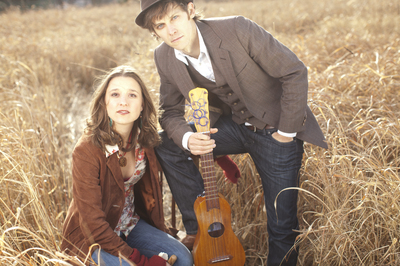The Ark hosts David Wax Museum for annual Student Welcome Show

The David Wax Museum plays this year's Student Welcome Show at The Ark.
Take the David Wax Museum, a group that combines the Mexican son jarocho style—indigenous to southern Veracruz—with American folk music, alt-country and indie rock. The music is mostly centered on the jarana—an 8-stringed instrument that looks like a large ukulele—and a donkey jawbone.
Those are the instruments played by the group’s core duo, David Wax and Suz Slezak, respectively.
David Wax’s discovery of Mexican music began while he was attending Deep Springs College, a non-traditional school that doubles as a cattle ranch. He spent summers working in rural Mexico with the American Friends Service Committee.
Later, after earning a degree at Harvard University, he headed back to the Mexican countryside on a year-long fellowship. There he discovered and fell in love with the son jorocho style of Mexican music. Initially, he formed a Mexican-folk band strictly devoted to the style, before forming the current band.
Wax actually studied three types of the Mexican son, which are among nine different son styles in Mexico. These styles have deep local folk-music roots, but also drew on Spanish styles and the music that African slaves brought over with them.
Meanwhile, Slezak grew up on a small farm in rural Virginia, learned the fiddle, and was raised on reared on traditional Irish, classical, old time and folk styles. She graduated from Wellesley College, traveled around the world on a Watson Fellowship to study textiles, and then met Wax when she returned to Boston.
PREVIEW
David Wax Museum
- Who: World-music group that sometimes consists of a duo, and other times a full band.
- What: Music that synergizes the Mexican son jarocho style—which is indigenous to southern Veracruz—with Americana, indie-rock and folk music styles.
- Where: The Ark, 316 South Main St.
- When: 8 p.m. Friday, Sept. 9.
- How much: Students, free with ID. Others, $10. Tickets available from The Ark box office (with no service charge); Michigan Union Ticket Office, 530 South State Street; Herb David Guitar Studio, 302 East Liberty Street.
Wax also plays acoustic guitar, and Slezak also shares vocal duties with Wax, often engaging in a call-and-response hollering.
But back to that donkey jawbone, a percussion instrument that is technically called a quijada, and is also indigenous to southern Veracruz.
“When David came back from Mexico and we were forming the band, he said he wanted me to play it, so I checked it out and learned it, and it took some practice,” says Slezak. She also had to buy some replacements after some of the teeth fell out. “People in the audience seem fascinated by it, and afterwards they want to touch it and see how it works. The teeth are loose, so they actually rattle when you hit it, which is why the sound is so unique.”
When recording their current album, “Everything is Saved,” one thing they wanted to do, says Slezak, is blend the Mexican and American influences in several different ways. “Like, sometimes we used the Mexican instruments on the more Americana-type songs to give them a different quality,” she says.
“Or, at times, we’d do a song that had an Americana-type rhythm, but we’d use the hand claps you hear in Mexican music, and David would be playing the jarana.”
Some of the songs on the disc, like “Yes, Marie,” are based on traditional Mexican songs, but Wax rewrote most of the lyrics, while retaining the chorus.
The new disc has a slightly different vibe than the band’s previous album, “because that one was made on the fly, in a much more DIY way, whenever we had the money.”
That disc had a simpler, more traditional-folk sound. But, this time, the duo had more money, and a producer, so they used different production techniques, more layered vocals, more complex rhythms, and used “a lot more electric guitar,” stresses Slezak.
“But it still has a pretty raw feeling, I think.”
It does indeed.
The current disc is the first of the duo’s three albums that features Slezak playing the donkey jawbone. “I’d been playing it live right along, but I didn’t feel like I was adept enough at it to play it on a record until this one,” she notes.
Wax is the clearly the primary source of the group’s Mexican-music foundation. But, while Slezak’s background is in American and Irish folk, she has come to love the Mexican style as well.
“David said that when he first heard and saw people playing this style, he found it very inspiring—not just because of the music itself, but that it was always a communal event,” says Slezak. “It’s played a lot at parties, and dances, and the people were passing the verses around when they sang, and a lot of people were always involved.
“That’s the kind of thing we’re trying to do—bring that joyful sensibility and energy.”
Kevin Ransom, a free-lance writer who covers music for AnnArbor.com, can be reached at KevinRansom10@aol.com.

